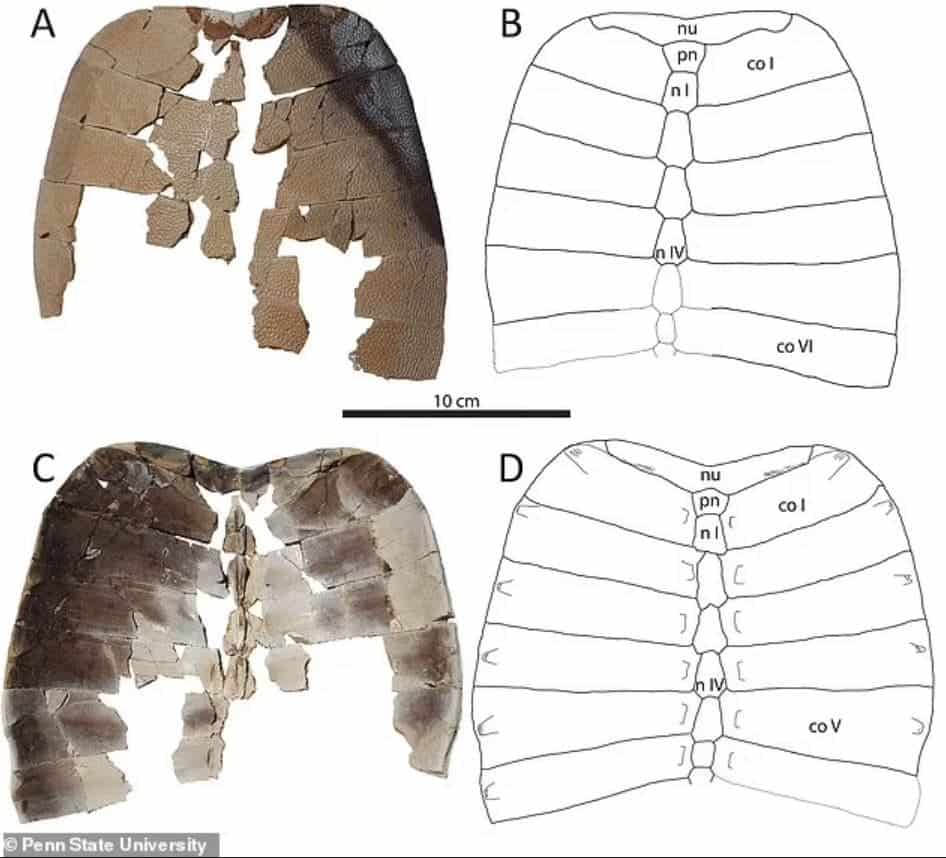Researchers led by members at the University of Pennsylvania’s Department of Earth and Environmental Sciences describe one of the earliest known species of softshell turtle. The animal lived 66.5 million years ago in what is today North Dakota and was unearthed back in 1975.

Christened Hutchemys walkerorum, this turtle lived at the same time as some very large and well-known species of dinosaurs, including Tyrannosaurus rex and Triceratops. According to the study describing the species, it is one of the earliest soft-shelled turtles ever discovered, giving us important information on the evolution of this group of animals. In particular, it lets us get a better understanding of what effect the end-Cretaceous mass extinction (the one that wiped out non-avian dinosaurs) had on the evolution of soft-shelled turtles.
Vintage turtle
“Until recently we didn’t understand these softshell turtles very well,” says lead author Steven Jasinski, who recently completed his Ph.D. in Penn’s Department of Earth and Environmental Sciences in the School of Arts & Sciences. “However, we are starting to get more information on this extinct group of turtles and further understanding their evolution, including how they dealt with the mass extinction.”
Hutchemys walkerorum belonged to the family plastomenines in the Trionychidae family, commonly known as softshell turtles. While related to these modern animals, H. walkerorum did have a few notable differences; one of the most important of these is that the plastron — the bone covering its stomach and abdomen — was more strongly sutured together, larger, and overall stronger than those of today’s softshells.
To the best of our knowledge, plastomenines lived between 80 and 50 million years ago, in the geological periods of the Cretaceous and Paleogene. Fossil evidence of these animals started to emerge during the Late Cretaceous and reached their highest diversity around the Cretaceous-Paleogene boundary (which is defined by the mass extinction). A single species is known to have continued into the Eocene Epoch (the period after the dinosaurs’ extinction) from fossil evidence.
The current specimen is a partial carapace, representing the bones that cover the back of the turtle’s ‘shell’, which was unearthed in 1975 in southwest North Dakota. It was discovered alongside a Triceratops specimen by a field crew from Appalachian State University. It was kept as part of the university’s collection until 2013, when it started to receive attention from researchers.
Based on the structure of this fossil, Jasinski and his colleagues determined its genus (the first part of its scientific name, Hutchemys). It represents one of a precious few examples of Hychemys prior to the mass extinction that brought the dinosaurs low, and it is also the easternmost occurrence of this genus ever found from the Cretaceous.
Research started in earnest around that time and continued as Jasinski was at Penn for his doctoral studies. Based on the structure of the specimen, he and colleagues determined that the animal belonged to the genus walkerorum. Hutchemys walkerorum represents one of the rare occurrences of these turtles prior to the mass extinction event that brought the Age of Dinosaurs to an end. It also represents the easternmost occurrence of the genus during the Cretaceous Period.
“With this study we gain further insight into winners and losers during the cataclysm that ended the Age of Dinosaurs,” says co-author Peter Dodson of the School of Veterinary Medicine and Penn Arts & Sciences. “The mighty dinosaurs fell, and the lowly turtle survived.”
A phylogenetic analysis — i.e. a comparison of this species with other known softshell turtles — allowed the researchers to determine that Hutchemys walkerorum and several related species comprise their own distinct group of derived plastomenines, which they named Plastomenini. The analysis also suggests that the roots of softshell turtles formed in Asia, from where the animals migrated into today’s North America sometime in the Late Cretaceous.
The species was named walkerorum in honor of Greg and Susan Walker, a philanthropic couple who created The Greg and Susan Walker Endowment in 2006. This endowment allows students in the Department of Earth and Environmental Science to apply for funding for projects that lack other sources of immediate resources. Jasinski was awarded Walker Research Grant funds for this project as well as others describing new species of dinosaurs, turtles, dogs, and investigations of dinosaurs and carnivorous mammals.
“The Walkers’ generous support helped me get the most out of my time while at Penn,” says Jasinski, “and I know they were vital to the research of other students as well. This was one of the major reasons we wanted to name this new species in their honor.”
The paper “A softshell turtle (Testudines: Trionychidae: Plastomeninae) from the uppermost Cretaceous (Maastrichtian) Hell Creek Formation, North Dakota, USA, with implications for the evolutionary relationships of plastomenines and other trionychids” has been published in the journal Cretaceous Research.






